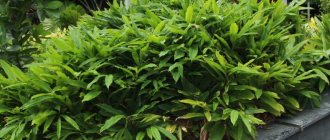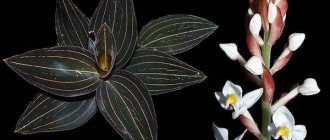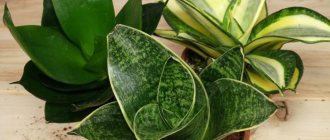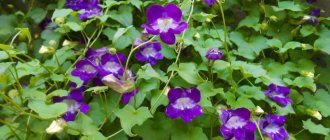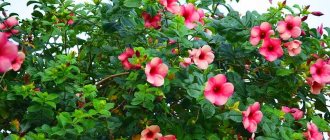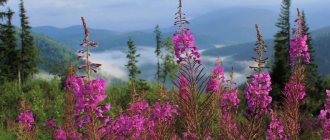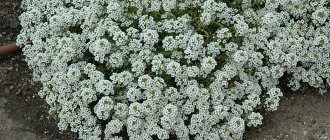Most often, when purchasing flowers in a store, you can find the words “orchid” on the label and nothing else. However, in order to properly care for a flower, it is necessary to determine the type of plant. In this article we will talk about what types of orchids there are, and also pay attention to the shape of the leaf plate, by which you can determine whether a plant belongs to a particular species. In addition, we will talk about how to properly carry out the process of propagation, watering, and also provide the home orchid with the necessary care.
There are a large number of types of indoor orchids that feel very comfortable in an ordinary apartment. They will be discussed in this article.
What does Ludisia look like?
Ludisia is often called the “precious” orchid because it has a rare quality difference - its leaves are not inferior in beauty to its flowers. Most often these are velvety dark green sheets with beautiful silver stripes.
Sometimes these can be dark leaves with a burgundy tint with light veins. The color of the leaves most often depends on the light they consume and the variety of ludisia.
Photos of the Ludisia orchid will greatly surprise you, because you will not see the usual lush flower. On a stem no more than 30 centimeters long you can see something similar to a miniature orchid. These are about 20 flowers on one stalk, the diameter of which reaches only 2 centimeters.
The flower itself is a composition of small white petals and a pronounced yellow stamen.
Appearance of the plant
Lycastes have a sympodial growth form. Two or three ovoid or pear-shaped pseudobulbs are connected by a rhizome. From their top grow 2–3 folded leaves, elliptical or elongated-oblong in shape. Peduncles, shorter in some species, up to half a meter in others, appear from the base of the pseudobulb, in numbers of 2–5 or more than ten in yellow-flowering varieties, but each bears a single flower with a circumference of 5 to 20 cm, incredibly beautiful and fragrant.
The petals themselves are small, covering the column, but the sepals are much larger, located at an angle of 120 degrees to each other and form a kind of triangle. It seems like a wax flower, its petals and lip are so tight. The palette of shades is different - from white and soft pink to greenish-yellow, orange and brownish. Flowering usually begins in summer and lasts about two months, but winter-flowering species are also found in the genus.
What types of ludisia are there?
All varieties of this plant have approximately the same flowers. Lydisia orchid can vary in leaf color and size, as well as its size. Today there are the following types:
- Dawsoniana - the leaves have a deep green color, which can be called black, the veins on the leaf have a red tint
- Rubrovenia - leaves have a beautiful bronze color with beautiful copper stripes
- Ordiana - classic appearance - dark green leaves with silver stripes
- Trilineata - large leaves in copper shades
- Grandis - large leaves in a classic color
- Condorensis - has a tall stem on which flowers grow
- Otletae - narrow leaves in red shades
What are "precious orchids"?
Jewel orchids are compact terrestrial species from the Orchidaceae family. Without exception, all plants belonging to this group of orchids are miniature and collectible. In nature, deciduous orchids can be found in Madagascar, Australia, South and East Asia. These are varieties with velvety leaves, decorated with luxurious edges, silver or gold veins, nets and cobwebs of patterns.
They have a basic cherry, gray, dark green or light green color combined with contrasting luminous patterns. But what variegated orchids definitely cannot boast about is the beauty of flowering. It is inferior to absolutely all representatives of the orchid family, but at the same time it is still capable of surprising with unusual details. Precious orchids produce simple small flowers, most often white, collected in loose clusters of inflorescences.
Against the background of velvety metallic greenery, the flowers seem radiant and surprisingly simple, but the contrast enhances their modest beauty and draws attention to the main advantages of the plant. An undoubted advantage of these types is also their strong aroma.
Flowering of Ludisia variegated. © maria kuzupi
How to care at home
All special conditions that must be created are directly related to where the plant comes from. The Ludisia orchid came to us from the tropics, which means that several important factors must be taken into account:
Temperature. This plant is accustomed to temperature changes. Ludisia is comfortable with an average temperature of +25 during the day, +20 at night. That is, at night she will be comfortable near a window with an open window.
Light. On a summer day, this plant loves shade, and in winter it needs additional lighting. Most importantly, you should avoid bright sunlight; soft, diffused light is ideal for ludisia.
Humidity. Ludisia loves humidity, however, unlike other plants, spraying it with water from a spray bottle can have unpleasant consequences.
Drops of water leave “scars” on the leaves that cannot be eliminated. An excellent way out of the situation would be to have a regular bowl of water that will stand next to this flower.
Watering. Ludisia loves humidity, but water should not be allowed to stagnate in the pot. Water for irrigation should be at room temperature, preferably pre-settled.
Cymbidium orchid species
- Miniature flowers are gaining great popularity, such as Cymbidium aloelifolia, which is only 30 cm high. It is distinguished by oval pseudobulbs. There are many flowers, they can be cream or dark red. Form brushes.
- Magnificent beige-white flowers, similar to ivory, are the virtue of Cymbidium eburneum, whose “lilac” scent fills the home atmosphere with the onset of spring.
- If a dark red vein penetrates light green petals, 5 centimeters wide, it is Cymbidium lanceolate.
- Cymbidium Lowe has huge greenish-yellow petals, 20 centimeters wide, and a crimson lip with a yellow border.
- Cymbidium is wonderful - Pale pink petals with red spots, and in the inflorescence there are up to 15 flowers, 7-8 centimeters in diameter. The edge of the anterior lobe is covered with purple and curved backwards.
- Giant cymbidium has green-yellow petals of more than 10 pieces and a diameter of at least 12 centimeters, covered with multi-colored stripes.
- Cymbidium dwarf. Curved, pointed leaves formed on short pseudobulbs only a few centimeters long. The brick-colored flowers are large, up to 10 centimeters.
- Cymbidium swordifolia. A straight thirty-centimeter peduncle bearing up to 9 flowers, 5 centimeters wide, with a wonderful aroma. The leaves are leathery and up to 90 centimeters long.
Photo gallery of the Cymbidium orchid.
Reproduction methods
Ludisia seeds are not so easy to find, and only experienced specialists can grow an orchid from them. Therefore, the following methods are used to propagate ludisia:
- division: to separate a stem with three or more shoots from an adult plant
- cuttings: cut off the top with 2-3 nodes, process and root
Pests, diseases and important details
The most common diseases in this species are:
Root atrophy. This occurs when temperature and watering regimes are not observed, in which the cymbidium bulbs lose their functions. Treated with proper care.
Yellowing of leaves . This is the result of improper lighting and insufficient moisture. Treated by changes in the above procedures.
Root system rotting. At the same time, the roots of the cymbidium turn black. It is the result of improper watering and detrimental humidity levels. It can be overcome by changing the watering regime.
Like other types of orchids, Cymbidium flowers are affected by pests. Usually they can be detected even with the naked eye, and if detected, you should immediately take action.
- Whitefly. Treated with bactericides and laundry soap solutions.
- Spider mites. The leaves of the flower seem to be covered with a thin light film. Increasing humidity and treating with antiseptics will save the flower.
- Thrips. Very similar to whitefly. And the choice of treatment method is also similar.
- Scaleworms. Small white lumps that are very harmful to the leaves of the flower. Mechanical removal and treatment with an antiseptic will save the orchid from death.
Responsibility for diseases and infections of cymbidium lies entirely on the shoulders of the owner of the flower.
This article describes the main milestones in caring for a beautiful representative of the orchid genus - Cymbidium.
Orchids with long thin leaves include plants of the Cymbidium variety. Its popularity is growing by leaps and bounds.
You can find this beautiful representative of the orchid family both on the windowsills of apartments and houses, and in bouquets. Hybrids adapted to home conditions are increasingly appearing in the homes of orchid lovers.
It is virtually impossible to find natural specimens in flower shops; they often sell artificially bred hybrids.
The long, narrow leaves are sword-shaped and form bushes reminiscent of iris bushes.
Peduncles grow at the base of false bulbs, and orchid inflorescences are quite large, can reach 15 centimeters in diameter. Primary colors:
Threats and diseases
All diseases of this plant are a consequence of improper care. The most common threats:
- rot: if it appears, check how to water the flower correctly and what is the watering rate for your type of ludisia - the formation of rot indicates that there was more than enough water
- white mold: forms on the ground if there is not enough fresh air in the room
- wrinkled leaves: indicate that the orchid is sorely lacking water
- burns on the leaves: they say that the orchid is in direct sunlight and needs to find a more shady place
- spider mites, aphids, whiteflies: growing at home is not often accompanied by the occurrence of such pests, but if the room is too hot and low humidity, the likelihood of their appearance is high
Orchids with small flowers
All types of orchids with small flowers can be divided into two groups :
- Small-flowered terrestrial perennials, common in temperate latitudes and, partially, in the subtropical and arctic zones. They grow in the wild and are only occasionally used for landscaping. Most of these species are endangered plants listed in the Red Book. Prominent representatives:
- Lady's slipper;
- Lyubka bifolia;
- The guide is radiant.
- Epiphytes with small flowers tropical and equatorial zones. Most species in this group are native to the countries of East and Southeast Asia, as well as Australia. Many of these orchids are widespread in indoor culture or used in hybrid breeding. Prominent representatives:
- Rhynhostilis obtuse;
- And Dendrobium Kinga.
When describing tropical beauties, a certain pattern :
- Most species with large flowers grow in South and Latin America;
- And small-flowered ones mainly come from the Asian region.
The first mentions of the “daughters of the air” are found in books of China written before 1600. They talk about the small-flowered Neophinetia, which Europeans described in Japan only in 1925. In the same place, but a little earlier - in 1863, Sidireya was found. And orchids with small flowers, such as Kaleana major or Dendrobium Kinga, were discovered for the first time in Australia.
Rhynhostilis
This genus of the Orchidaceae family can be classified as a very small community - according to various sources, it consists of 4 - 6 species that were previously part of the Vanda genus.
A distinctive feature of Rhynhostilis are the inflorescences :
- Luxurious drooping brushes up to half a meter long or more;
- Densely composed of several dozen small flowers;
- And spreading a pleasant, lasting aroma.
Many small flowers grow on the thin stem of the Rhynhostilis orchid.
According to the method of growth, representatives of the genus belong to epiphytic plants, which allows them to rise towards the light in dense tropical forests, but at the same time be protected from direct sunlight .
The monopodial type of growth explains the presence of one thick and rather short (about 10 cm) stem in the plant, on which vaginal leaves alternately develop. The dark green leaf blade ends with a sort of torn edge, which is also characteristic of the genus. An orchid with small flowers, you can see the photo below.
The flowering times of the species do not coincide :
- Some orchids bloom in midsummer;
- Others prefer autumn and even winter.
But the general structure of the flower, the column of which resembles the shape of a bird's beak (rhynchos in Greek), gave its name to the entire genus.
The color does not differ in variety - there are :
- White;
- Pink;
- Blue;
- And colorful options.
But the royal inflorescence can be forgiven for such a shortcoming. In terms of how long the flowers last, the tropical beauty belongs to the long-blooming type.
ATTENTION! Orchids of the genus Rhynhostilis are often found in home culture due to their fairly simple care requirements. But they live for a very short time: in nature - about six, and indoors - up to a maximum of 4 years.
In addition to pure species, flower growers encounter intergeneric hybrids based on representatives of the beaked species, which retain luxurious inflorescences as a sign of the genus.
Homeland and area of growth in nature
Orchids of the genus Rhynhostilis were first described and still grow :
- In natural conditions of mainland Southeast Asia;
- And also in Philippine;
- And the Indonesian islands.
Instances of various types can be found :
- In the humid tropics of Cambodia;
- China;
- Laos;
- Vietnam;
- Thailand and other countries in this region.
Plants of the genus are chosen by the tropical forests of island countries (Philippines and Indonesia), where they grow quietly at an altitude of up to 700 m above sea level.
External characteristics
Representatives of the genus have a short and thick stem, on which alternate leaves and drooping inflorescences are densely formed. The shoot develops vertically and does not grow more than 10 cm.
Powerful roots do not require a substrate to grow. They prefer to weave loosely around small wooden basket-type structures to keep the plant upright. Numerous aerial roots are protected by a thick layer of velamen.
The leaf plate can grow up to 35 cm. It is a rigid resemblance to a belt (since the width of the sheet does not exceed 5 cm), the similarity of which is added by the end of the sheet, torn in the form of a double tongue. Red and purple spots clearly appear on the dark green leaves.
Peduncles are the main pride of this plant: from 20 to 100 small flowers are collected in a dense brush (from 40 cm), which grows from the axils of old leaves in a month and a half and hangs from the container. In the inflorescence, the opening of flowers occurs gradually, so flowering can last from 3 to 6 weeks.
The flowers of the Rhynhostilis orchid are very small.
The flowers are very small (diameter within 2 cm), as if made of wax. The color of the narrow petals and rounded sepals is the same, slightly lighter than the color of the triple lip. The column resembles a beak. The flower has a spur at the back. Possible coloring :
- White;
- Pink with spots;
- Blue;
- And raspberry.
The appearance of buds occurs in mid-summer or during the autumn-winter period, depending on the species .
Varieties
Dulled
Carl Linnaeus described R. dulled back in the mid-18th century. Grows throughout East and Southeast Asia, loves moist alpine forests .
Rhynchostylis retusa (Blunt) 80 cm long.
A medium-sized orchid with small flowers, with curved leaf blades. The inflorescence grows up to 60 cm and unites more than 100 flowers. The color is soft pink with dark pink spots and a lip of the same color. Blooms between winter and spring. Symbol of the Indian state of Assam .
It is used in medicine for healing wounds , used in decorative landscaping, and also as decoration at weddings and when welcoming important guests.
Heavenly
Under natural conditions it is found in only 4 countries :
- In Thailand;
- Laos;
- Cambodia;
- And Vietnam.
Rhynchostylis coelestis Heavenly.
Loves dry deciduous forests and high mountain areas. A small orchid that barely grows to 20 cm. The shoot produces aerial roots, similar in thickness to wires.
The leaves look like a narrow belt , since the width of the plate is no more than 3 cm. In length - up to 20 cm. The inflorescence is less impressive than that of R. obtuse, only 20 cm. The flowers are also more miniature, their diameter is from 1.2 cm to 2 cm, have a vanilla aroma.
The color of the flowers gives the species its name:
- Petals and sepals are white;
- Colored blue;
- And purple stains;
- And the tip of the white lip sparkles with blue paint.
Blooms for a long time: from April to December.
Rifera
It lives only in the Philippines , that is, it is endemic.
The inflorescences grow about 36 cm and consist of tiny (up to 1 cm in diameter) white flowers with a strong scent. We were unable to find a photo.
Growth and life cycle
Planting and placement in the house
IMPORTANT! They do not require planting in a substrate due to the need for aeration of the roots - just secure the plant with a large piece of pine bark on a block or in a wooden basket.
In indoor conditions, it is difficult to adapt to changes in lighting, so they should be kept in the same place - on a windowsill with bright lighting and protection from direct rays.
The Rhynhostilis orchid has a hard time taking root indoors.
It is preferable to place it on south-facing windows.
Rules of care
The temperature is the same at any time :
- Preferably at least 23 degrees during the day;
- And 5-8 degrees less at night.
Without temperature changes, orchids refuse to bloom. They require strong illumination for at least 10 hours a day, but are afraid of direct sunlight.
Water plants without substrate with warm water in the morning so that the roots dry out by evening. When growing using bark, water only after it is completely dry.
To maintain high (more than 70%) air humidity, be sure to use a humidifier . Feed throughout the growing season by adding fertilizer to the irrigation water, but not more often than every two weeks.
Reproduction methods
They do not reproduce in indoor culture - only sometimes they produce weak babies, which should be carefully separated after the roots have formed.
Rhynhostilis orchids are difficult to reproduce in apartment conditions. Pictured is Coelestis.
In large greenhouses they are grown from seeds or cloned.
Diseases and growing problems
The only pests found are aphids - treat with insecticide .
Affecting diseases - rot of various natures . They arise from waterlogging and low temperatures. To control - change the conditions of detention, if necessary, treat with a fungicide.
ADVICE! The main problem when growing is the lack of flowering. It occurs due to low lighting, lack of temperature difference, frequent movement of the plant or violation of the watering regime. To eliminate it, check the conditions of detention .
Features of flowering
Time
Orchids, depending on the species, can bloom at any time of the year :
- R. obtuse blooms from January to April;
- And R. celestial prefers warm weather - from April to November.
Peduncles form within 1-1.5 months.
External characteristics of the peduncle and flowers
Inflorescences in the form of a brush are the main pride of plants of this species. They are much longer than the stem, drooping in shape, and consist of a large (from 20 to 100) number of flowers tightly adjacent to each other. The size of the brush, depending on the type, varies from 20 to 60 cm.
The flowers are small (1.2 - 2.5 cm), white, pink, blue or crimson in color with a contrasting tinted lip. Comprises :
- Two narrow petals;
- Three rounded sepals;
- Lips with curved sides;
- And a small spur at the back.
The beak-shaped column gives the genus its name.
Duration
The flowers in the inflorescence begin to open in order of priority , so the flowering period can stretch from 2 to 6 weeks - in different species in their own way.
Start
An orchid begins to bloom when it has successfully completed vegetative growth , that is, it has developed a powerful root system and several leaves have formed. Peduncles appear in the axils of the lower leaves. The older the plant, the more inflorescences it can form.
Repeated
Due to the long main flowering period, re- formation of flower stalks is impossible - the plant must rest and gain strength for the next season.
Greater Kaleana (Caleana major)
A very unusual and rare orchid, the flower of which in appearance resembles a small duck with its wings spread for flight.
Caleana major - Flying duck.
This is an Australian endemic - it can only be found in the southeast of the continent, where it hides in swampy thickets, eucalyptus forests or mountainous areas. Not an epiphyte.
A miniature orchid (no more than half a meter) has only one leaf (size 12 cm x 0.8 cm) and produces 2-4 flowers. The diameter of the flower barely reaches 2 cm. The orchid is painted in bright colors :
- Red-brown;
- Violet;
- Less often green with pink streaks.
The blooming orchid can be found from September to January. Pollination occurs by luring an insect into a flower trap.
It grows only in the wild, where it is very difficult to detect. Does not take root in indoor culture.
Dendrobium parviflora
Representative of the Asian region. This orchid is small-flowered. It belongs to the “aerial orchids” and in appearance, especially during the dormant period, like all plants of the genus, it is a bit reminiscent of bamboo .
Small-flowered Dendrobium Berry Oda.
A peculiarity of this genus is the ability to form daughter shoots after the end of the growing season of the main stem, which significantly increases the lifespan of each specimen.
This is a full-cycle plant, that is, without a dormant period in the fall, flowering will not occur - instead of buds, children will appear.
Flowering occurs from mid-summer to October. Peduncles are erect with several (from 10 pieces) flowers. The diameter of flowers is measured within 2 cm. Petals and sepals :
- Slightly elongated;
- Same in size;
- Snow-white color.
The lip is widened, white with purple lines. One plant can form a whole bouquet of peduncles due to daughter shoots.
Neophinetia crescenta
This species grows :
- On the Japanese islands;
- It is also found in Korea;
- And China.
Neofinetia falcata "Akausagi".
Perennial representatives of the species can lead an epiphytic and lithophytic lifestyle. In their natural habitat they grow in clumps of sufficient density.
The orchid simultaneously forms several small inflorescences , which do not exceed 8 cm. 3-7 milky-white flowers bloom on the peduncle, emitting a pleasant aroma in the evening. The petals, lip and sepals are of the same narrowly elongated shape. The flower is no more than 2 cm; at the back it has a long spur, twice the size of the petals.
Rare forms of N. crescenta are colored in various rainbow tones . Flowering occurs in the spring-summer period - from April to August, pollinated by moths and moths.
Attention! At home, N. crescenta needs a winter dormancy period.
Sedirea japonica
Perennial epiphyte found in the southern regions of Korea and Japan. Sometimes it can lead a lithophytic lifestyle.
Sedirea japonica.
It does not require a period of rest in winter, but for active flowering it requires a temperature difference during the growing season.
Flowering can occur at any time of the year , but the orchid blooms especially often in the summer months.
Drooping peduncles of this species form up to a dozen small (no more than 3 cm) flowers. The petals and sepals are narrow, the lip widens at the end. The color of the flowers is white or yellow-green with a brighter tone and burgundy stripes at the lip. The plant exudes a strong citrus aroma .
Ludisia transplant
The description of the flower suggests that it is not prone to intensive growth in height. Ludisia most often grows as a beautiful bush horizontally. The root system of the flower also behaves. That is why low but wide pots and cache-pots are chosen for ludisia.
As soon as the orchid has stopped growing, this means that the plant is becoming cramped in its pot and it is time to replant. As a rule, this happens once every few years.
It is better to transplant ludisia in the spring. To make it gentle on the plant, you can take soil as a substrate and mix it with peat.
Description
Cymbidium was first discovered and studied by botanist Olof Swartz in 1800. Translated from Greek, cymbidium means boat-shaped, because the shape of the flower of this type of orchid resembles a boat. The flower belongs to the genus of evergreen epiphytes and lithophytes - it can grow not only on the ground, but also on rocks and trees.
Cymbidium orchid is a sympodial species. Currently, more than 60 of its species are known. You can find it in nature in Australia, the Himalayas (Nepal), Thailand, and India.
The height of the plant ranges from 1 to 15 centimeters. Pseudobulbs are oval-shaped, tightly pressed to each other. The leaves are narrow, rather long, rounded or pointed at the ends. Peduncles are elongated or hanging, growing from the base of young pseudobulbs. Flowers of various shades, diameter up to 13 centimeters. They are aromatic with a strong and pleasant smell. The orchid blooms for quite a long time - up to 10 weeks.
Bloom
“The Queen of Fragrances” is what Confucius called cymbidium. This type of orchid has a fairly wide flowering period: some bloom in spring, others in summer. There are some that bloom from autumn to winter. It all depends on the variety, the number of peduncles, lighting and ambient temperature. The duration of flowering in different species can vary from 6 weeks to 3 months. During the flowering period, the ambient temperature should not exceed 22 degrees Celsius.
Pruning Ludisia
Ludisia is a compact plant that does not require growth control or intervention in the form of pruning. However, sometimes this is a necessary measure.
Indoor care may require pruning only if during the period when the orchid is still forming. If you notice that the stem with the flower has begun to grow too rapidly and this has noticeably deteriorated the quality of the leaves, you need to remove it. This will help save the plant from inevitable death.
Ludisia is one of the most unusual types of orchids; it always stands out with its non-standard appearance against the background of other plants. If you love orchids and know in what conditions to keep this indoor plant, be sure to add it to your collection.
Precious foliage patterns of variegated orchids
Orchids have no more advantages than disadvantages. These plants boast a rare palette of colors and patterns, as well as elegant flower shapes. But to no lesser extent they are characterized by a love for specific growing conditions and high demands on care. One of the main disadvantages of all orchids is their limited decorative period. When the beautiful flowering ends, the plants are instantly lost in the collection and do not stand out in any way from other wintering crops. But there is a surprising exception to this rule. Jewel or variegated orchids remain attractive throughout the year and look fresh at any time.
But still, the main advantage of these rare, but not the most capricious orchids remains the much more spectacular foliage, which is in no way inferior in beauty to the flowers of more popular species. Precious orchids cannot exactly be called inconspicuous green. Variegated, spectacular, it immediately attracts attention with the play of textures and unusual reflections of the veins that literally glow on the leaves. Such orchids are called precious due to the fact that the texture of the leaves is reminiscent of gems and veins of precious metals. The second name for this group of decorative miniature orchids is the more modest name “variegated orchids.”
Photo of the Orchid Ludisia plant
Diseases and pests
The most common diseases and pests of orchids:
- spider mite , due to which the leaves of the plant fade. Treated by spraying and wiping with regular beer;
- thrips , which are transmitted from other plants. Accelerates flowering, and can be treated by spraying with any insecticide;
- with too much watering and improper care conditions, the root system is subject to rotting . In such cases, it is necessary to urgently replant the plant and not water until new roots form.
Caring for a home orchid during flowering
The agricultural technology of these wonderful plants has its own characteristics, which is why many people believe that orchids are difficult flowers to grow. In fact, this is not entirely true, the main thing is to know the basics, and also strictly adhere to the recommendations that are given for a specific type and variety of plants. Moreover, today there are many orchid hybrids that are created specifically for growing indoors.
Lighting
Not every type of orchid requires any special lighting regime; usually the amount of light that passes through the windows of city apartments is enough.
Lighting may be required in the dark season (especially for the regions of the North-West), as well as for plants that grow on the northern windowsills of the apartment.
ON A NOTE!
It is convenient to use fluorescent lamps.
Gemaria and phalaenopsis require the least amount of light, but for growing some types of dendrobiums and vandas, which grow in light seasonal forests and on the tops of tropical trees, good lighting is needed.
Temperature
An important condition for successful flowering of all types of orchids is the creation of the correct temperature regime.
There are three main groups of orchids:
- Plants that need to create lower temperatures in winter, as well as in summer (at night). So, in the winter season, these orchids require a temperature no higher than +4... +7ºC, while the summer night temperature should not be higher than +12 ºC. If such conditions are not created, you will not be able to wait for the flowering of such types of orchids as lalias, cymbidiums, and lycastes.
- Orchids that can be successfully grown under normal indoor conditions and for which +15 ºC (maybe a little higher) is enough. Cattleyas, oncidiums - these are the species that are the most undemanding in terms of temperature.
- Maxillaria, phalaenopsis, and some types of oncidium need the most heat. The temperature should not be lower than +16…+17 ºC, with each type requiring certain values. In order for plants to bloom, you need to carefully study the temperature requirements of each species.
Watering
An interesting paradox: orchids are plants that generally consume small amounts of moisture, but at the same time, in order to bloom, it is necessary to strictly observe the flower irrigation regime.
IMPORTANT!
When determining the watering regime for orchids, it is necessary to take into account the type and level of humidity of the substrate in which the flowers grow and the level of air humidity.
When the plant is at rest, watering is practically stopped; during periods of intensive growth, it is increased. At the same time, the condition of the substrate is monitored so as not to get an excess of moisture in it, stagnation of water and, as a result, rotting of the flowers.
In terms of air humidity: most orchid species require humidity in the range of 60-80%. It is difficult to create such conditions in apartments, but it is possible. To do this, they usually spray the aerial roots of plants, as well as the foliage with a spray bottle.
ON A NOTE!
The time for spraying is chosen so that the moisture has time to dry before evening and night. Also, do not spray plants that are in direct sunlight.
Transfer rules
In general, orchids do not need frequent replanting. A signal that it’s time to “move” to a new pot - the roots become crowded, the soil has become less porous, and a white coating is observed.
IMPORTANT!
Orchids do not like to be disturbed, so you should always calculate the volume of the container and the quality of the substrate when planting.
Before replanting the plant, water it carefully (about a day in advance) so that the roots are more flexible. Old and dead roots are removed, and the cuts are sprinkled with crushed charcoal.
If the plant has grown too much, you can divide it, and a separate container with substrate should be prepared in advance for each part. It is mandatory to have drainage, as well as a special wire support for the orchid. The roots should be positioned freely, after which they are carefully sprinkled with substrate. The orchid must be tightly secured.
After replanting, the plant is provided with gentle conditions:
- remove from bright rays;
- provide coolness and the desired level of humidity.
It is not necessary to water in the first days; it is better to spray.
IMPORTANT!
The watering regime must fully comply with the requirements of a particular type of orchid.
It is advisable to carry out all work with gloves, while replanting different types of orchids should be done with different gloves (so as not to spread possible diseases).
Reproduction
The most common method used for propagating orchids indoors is vegetative propagation. This can be done either by dividing the bush, cuttings, or using stem shoots (for a plant with pseudobulbs).
- Reproduction by children. Such babies are formed on adventitious buds, as well as on peduncles. They are separated as soon as the children begin to form their own roots. This is how phalaenopsis is most often propagated.
- Dividing the rhizomes of a bush. This option is usually used when transplanting plants. The root is cut into pieces with pruning shears, leaving several pseudobulbs on each section.
- Division of a plant stem. Used in monopodial orchid species that do not form bulbs. In this case, carefully divide part of the plant stem so that aerial roots are present on each part. Place the divisions in the substrate.
ON A NOTE!
Such divisions take root best in sphagnum moss or wet sand in a special miniature greenhouse.
Bloom
Orchids usually bloom when they reach the age of 2 years, but only if they are provided with the right growing conditions.
IMPORTANT!
When purchasing a plant in a specialized store, be sure to check the age of the flower.
In order to make an orchid bloom, it is often necessary to create a special temperature regime. Its peculiarity is the temperature difference between day and night. Usually the difference is up to 8 degrees.
Another trick: reducing watering for two weeks.
As soon as the orchid begins to form buds, watering is increased; many species also require a higher, stable temperature during this period. For flowering orchids, it is necessary to make supports so that the flower stalks do not break.
Typically, most orchids bloom for several months. Flowering can be either continuous or in stages. Everything is conditioned and depends on the plant variety, species, age.
During the flowering period, rearranging orchids is not allowed, as this may lead to the dropping of buds. It is recommended to maintain a stable watering regime, provide optimal lighting and temperature. If everything is done correctly, the orchid will bloom for a long time.
It is also recommended that during long-term flowering, fertilize the plant approximately once every 7-10 days. For this purpose, special means are used, in which potassium and phosphorus should predominate. All faded flowers are removed.
After the orchid has bloomed, the bare peduncle is carefully removed.
ON A NOTE!
After removing the peduncle, a small hole may remain. It is better to cover it with beeswax so that when watering, moisture does not get inside the orchid.
Only the dried peduncle is removed, but if it has a green end and has not withered, it is not touched. There is a chance that in the very near future it will begin to form buds again.
After flowering ends, the orchid goes into a dormant period. At this time, the plant can be replanted; it is also necessary to create special conditions for watering, lighting, and temperature. The dormant period lasts differently for all types of orchids, so it is necessary to take into account the characteristics of each variety.
Origin story
The plant was cultivated by the Chinese more than 2,000 years ago. The first botanical description was made by Peter Swartz in 1799.
Today, the plant is most widespread in Japan and China; species with small flowers are especially popular because they have an intense aroma.
There are varieties with different shades of leaves and flowers; in Europe and Australia it is especially valued as a cut crop. Under natural conditions it is found in the north of Australia and in the subtropics of Asia.
Feeding and fertilizers
Cymbidium needs feeding only during the flowering period. This usually happens in two stages:
- the first time at the beginning of flowering;
- the second time at the end.
For feeding and fertilizing, you can use the most common universal mixture, but it must be diluted in a concentration less than that indicated in the instructions, at least twice.
IMPORTANT! It is not recommended to feed cymbidium in winter. It is also strictly forbidden to feed a sick plant, this will only worsen the situation and lead to death.
Types and names of varieties
The most popular types of cymbidium among gardeners are:
- aloe leaf;
- Lowe;
- Day;
- Tracey;
- lanceolate;
- sword-leaved;
- wonderful;
- dwarf;
- giant.
There are about 50 species in the Cymbidium genus, and there are several thousand hybrids. Some appeared in nature, others were bred by breeders to produce dwarf plants suitable for home breeding.
